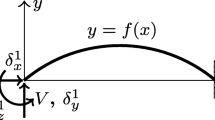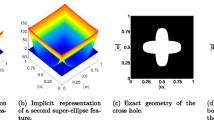Abstract
A simple systematic approach is presented for designing a spatial link mechanism with partially rigid joints. A linear programming (LP) problem to find an infinitesimal mechanism that maximizes the output displacement is first formulated. The objective function of this LP problem has a penalty term to obtain a sparse solution including small numbers of hinges and members to be removed. It is shown that the dual of this LP problem can be regarded as a plastic limit analysis problem that maximizes the load factor under the equilibrium condition and upper- and lower-bound constraints on the member-end forces of a given frame structure. A heuristic approach is presented to obtain a finite mechanism by solving the LP problem after updating the nodal locations in the direction of inextensional deformation. It is shown in the numerical examples that various planar and spatial mechanisms can be easily found using the proposed method.
















Similar content being viewed by others
References
Artobolevsky A (1977) Mechanisms in modern engineering design. MIR Publishers, Moscow
Avilés R, Vallejo J, Ajuria G, Agirrebeitia J (2000) Second-order methods for the optimum synthesis of multibody systems. Struct Multidiscip Optim 19:192–203
Avilés R, Vallejo J, Fernández de Bustos I, Aguirrebeitia J, Ajuria G (2010) Optimum synthesis of planar linkages using a strain-energy error function under geometric constraints. Mech Mach Theory 45:65–79
Candès EJ, Wakin MB, Boyd SP (2008) Enhancing sparsity by reweighted ℓ 1 minimization. J Fourier Anal Appl 14:877–905
Chen S, Donoho D, Saunders M (1998) Atomic decomposition by basis pursuit. SIAM J Sci Comput 20:33–61
Collard J-F, Gosselin C (2011) Optimal synthesis of a planar reactionless three-degreeof-freedom parallel mechanism. J Mech Robot ASME 3(041009)
Dassault Systèmes Simulia (2013) ABAQUS Ver. 6.13 Documentation
Erdman AG (1981) Three and four precision point kinematic synthesis of planar linkages. Mech Mach Theory 16:227–245
Erdman AG (1995) Computer-aided mechanism design: Now and the future. J Mech Des ASME 117(B):93–100
Fernández-Bustos I, Aguirrebeitia J, Avilés R, Angulo C (2005) Kinematical synthesis of 1-dof mechanisms using finite elements and genetic algorithms. Finite Elem Anal Des 41:1441–1463
Freudenstein F (1995) Approximate synthesis of four-bar linkages. Trans ASME 77:853–861
Gill PE, Murray W, Saunders MA (2002) SNOPT: an SQP algorithm for large-scale constrained optimization. SIAM J Optim 12:979–1006
Jiménez JM, Álvarez G, Cardenal J, Cuadrado J (1997) A simple and general method for kinematic synthesis of spatial mechanisms. Mech Mach Theory 32:323–341
Jirásek M, Bažant ZP (2002) Inelastic analysis of structures. Wiley, Chichester
Katoh N, Tanigawa S (2009) On the infinitesimal rigidity of bar-and-slider frameworks. In: Dong Y, Du D.-Z, Ibarra O (eds) Algorithms and computation, lecture notes in computer science, vol 5878. Springer-Verlag, Berlin, pp 524–533
Kawamoto A (2005) Path-generation of articulated mechanisms by shape and topology variations in non-linear truss representation. Int J Numer Methods Eng 64:1557–1574
Kawamoto A, Bendsøe MP, Sigmund O (2004a) Planar articulated mechanism design by graph theoretical enumeration. Struct Multidiscip Optim 27:295–299
Kawamoto A, Bendsøe MP, Sigmund O (2004b) Articulated mechanism design with a degree of freedom constraint. Int J Numer Methods Eng 61:1520–1545
Kim YY, Jang G-W, Park JH, Hyun JS, Namm SJ (2007) Automatic synthesis of a planar linkage mechanism with revolute joints by using spring-connected rigid block models . J Mech Des ASME 129:930–940
Krishnamurty S, Turcic DA (1992) Optimal synthesis of mechanisms using nonlinear goal programming techniques. Mech Mach Theory 27:599–612
Liu Y, McPhee J (2004) Automated type synthesis of planar mechanisms using numeric optimization with genetic algorithms. J Mech Des ASME 127:910–916
Lobo MS, Fazel M, Boyd S (2007) Portfolio optimization with linear and fixed transaction costs. Ann Oper Res 152:341–365
Matoušek J, Gärtner B (2007) Understanding and using linear programming. Springer-Verlag, Berlin
Minnaar RJ, Tortorelli DA, Snyman JA (2001) On nonassembly in the optimal dimensional synthesis of planar mechanisms. Struct Multidiscip Optim 21:345–354
Nam SJ, Jang G-W, Kim YY (2012) The spring-connected rigid block model based automatic synthesis of planar linkage mechanisms: numerical issues and remedies. J Mech Des ASME 134:051002
Natarajan BK (1995) Sparse approximate solutions to linear systems. SIAM J Comput 24:227–234
Ohsaki M, Katoh N, Kinoshita T, Tanigawa S, Avis D, Streinu I (2009) Enumeration of optimal pin-jointed bistable compliant mechanisms with non-crossing members. Struct Multidiscip Optim 37:645–651
Ohsaki M, Nishiwaki S (2009) Generation of link mechanism by shape-topology optimization of trusses considering geometrical nonlinearity. J Comput Sci Tech 3:46–53
Olson DG, Erdman AG, Riley DR (1985) A systematic procedure for type synthesis of mechanisms with literature review. Mech Mach Theory 20:285–295
Pucheta MA, Cardona A (2013) Topological and dimensional synthesis of planar linkages for multiple kinematic tasks. Multibody Syst Dyn 29:189–211
Root RR, Ragsdell KM (1976) A survey of optimization methods applied to the design of mechanisms. J Eng Ind ASME 98:1036–1041
Rudin LI, Osher S, Fatemi E (1992) Nonlinear total variation based noise removal algorithms. Physica D: Nonlinear Phenom 60:259–268
Sedlaczek K, Eberhard P (2009) Topology optimization of large motion rigid body mechanisms with nonlinear kinematics. J Comput Nonlinear Dyn 4:021011
Stolpe M, Kawamoto A (2005) Design of planar articulated mechanisms using branch and bound. Math Program 103:357–397
Tibshirani R (1996) Regression shrinkage and selection via the lasso. J Royal Stat Soc Ser B (Methodol) 58:267–288
Tibshirani R (2011) Regression shrinkage and selection via the lasso: a retrospective. J Royal Stat Soc Ser B (Stat Methodol) 73:273–282
Tsuda S, Ohsaki M, Kanno Y (2013) Analysis and design of deployable frames with partially rigid connections. Proc IASS Ann Symp. Int Assoc Shell Spatial Struct ,Wroclaw, Poland, paper no. 1138
Vallejo J, Avilés R, Hernández A, Amezua E (1995) Nonlinear optimization of planar linkages for kinematic syntheses. Mech Mach Theory 30:501–518
Zhang C, Norton RL, Hammonds T (1984) Optimization of parameters for specified path generation using an atlas of coupler curves of geared five-bar linkages. Mech Mach Theory 19:459–466
Author information
Authors and Affiliations
Corresponding author
Additional information
An earlier version of this paper was presented at the 10th World Congress of Structural and Multidisciplinary Optimization (WCSMO10), Florida, USA, May 19–24, 2013.
Appendix
Appendix
We can obtain problem (11a) in Section 3.3 as a dual problem of problem (10a) in Section 3.2 from any standard duality theory of convex optimization. We here adopt the Lagrangian duality theory for explaining the derivation.
For notational convenience, rewrite problem (10) as
The Lagrangian of problem (13a, b, c) can be defined by
where \(\boldsymbol {v} \in \mathbb {R}^{n}\), \(\boldsymbol {y} \in \mathbb {R}^{n}\) and \(\lambda _{\text {in}} \in \mathbb {R}\) are the Lagrange multipliers. Indeed, problem (13) can be expressed by using L as
because we have that
Then the Lagrangian dual problem is defined by
Observe that the relation
Rights and permissions
About this article
Cite this article
Ohsaki, M., Kanno, Y. & Tsuda, S. Linear programming approach to design of spatial link mechanism with partially rigid joints. Struct Multidisc Optim 50, 945–956 (2014). https://doi.org/10.1007/s00158-014-1094-y
Received:
Revised:
Accepted:
Published:
Issue Date:
DOI: https://doi.org/10.1007/s00158-014-1094-y




